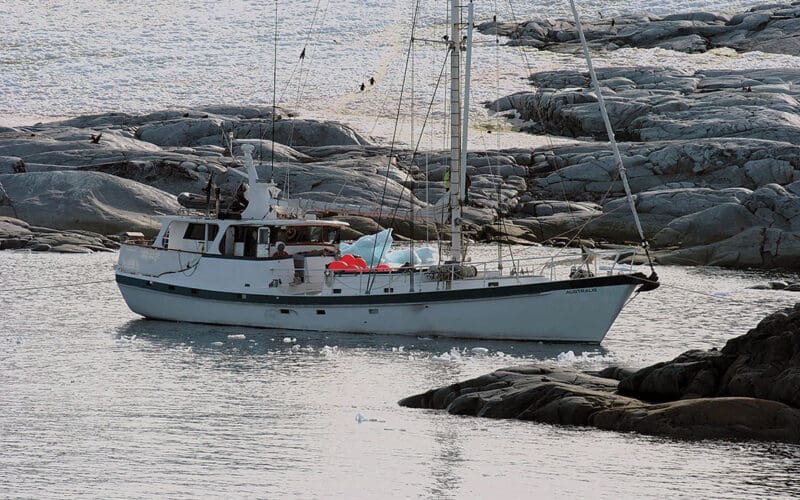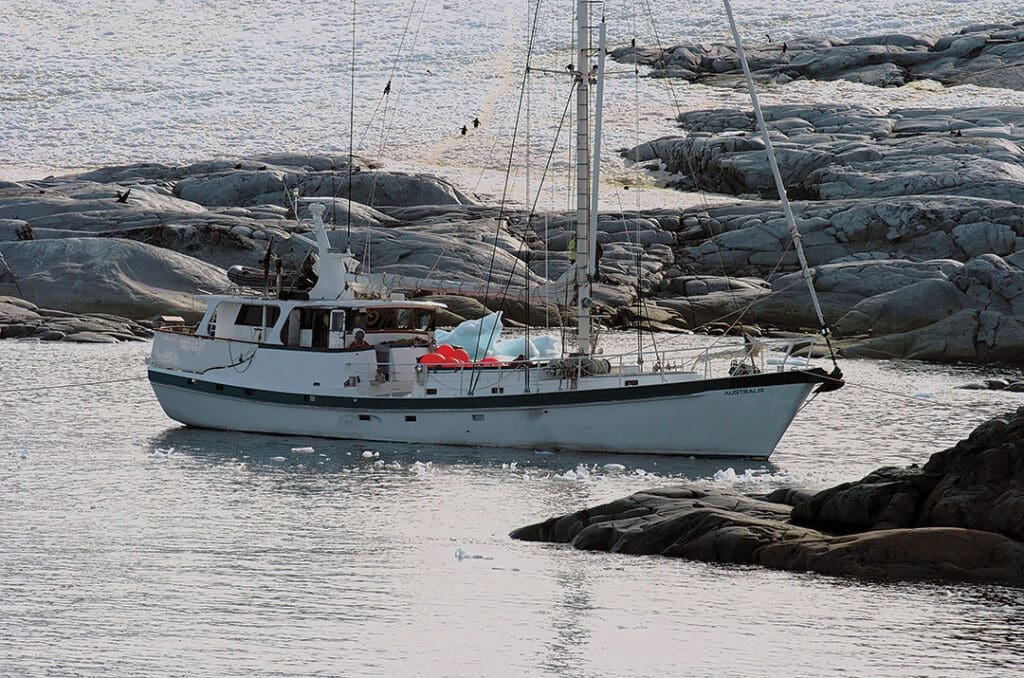
Steel ships are the backbone of world trade, and navies around the world maintain their allegiance to the metal. Like-minded builders of smaller commercial fishing boats, tugs and barges also favor the iron/carbon amalgam. So why do we see so few recreational power and sailing vessels being built from what’s arguably the strongest and one of the least expensive boatbuilding materials? Before attempting to answer, it makes sense to take a close look at what steel has to offer.
Riveted iron was the first step in a ship building renaissance, a trend that gave white oak and spruce trees a bit of a reprieve. Eventually, carbon was added to iron increasing its tensile strength and stiffness. At about the same time, welding expedited the building process and steel plate was cut and shaped using highly directable flame heat from oxyacetylene torches. Today, steel can also be cut with laser, plasma, waterjet, and saw blade technology. Metal workers bend hull plate over steel frames, tack weld the plate in place and eventually carefully fuse all the seams together.
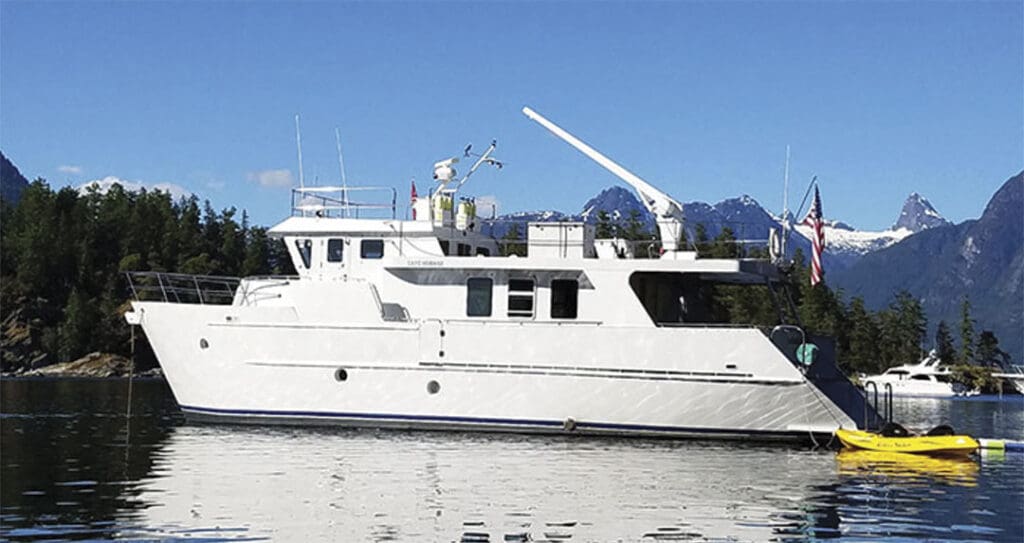
Stick welding became a highly prized craft essential to how frames were tacked in place and plate-to-plate seams were joined. At the heart of the process is the welder’s electrical transformer, a tool that turns AC current into lower voltage higher amperage DC current with the capacity to melt metal. Its lower voltage dissipates the shock hazard. Electrical welding harnesses an intentional short circuit. The positive and negative leads meet at the point where the welding rod touches the grounded plate. A key factor in welding involves smoothly working the rod across the seam allowing the high current to momentarily turn both the rod tip and plate into molten metal. When the steel “weld pool” cools, the resulting joint is as strong or even stronger than the hull plate itself.
Pluses and minuses
Mild steel, as a material, has a long list of desirable attributes along with a couple of potential showstoppers. On the plus side, resides toughness, malleability, and isotropic strength (equal strength in all directions). The net effect of these attributes includes abrasion resistance and a structure that reacts to point loads by deforming rather than tearing. It’s also the least expensive of modern small craft building materials and is relatively easy to repair. The build process can be expedited using computer aided design (CAD), numerically controlled cutting (NC) and laser, plasma or waterjet cutters that steel suppliers use to provide pre-cut hull plating that fits together like puzzle pieces. Steel boat designer Michael Kasten has found that this service can cut building time of a 45-footer by up to 40%.
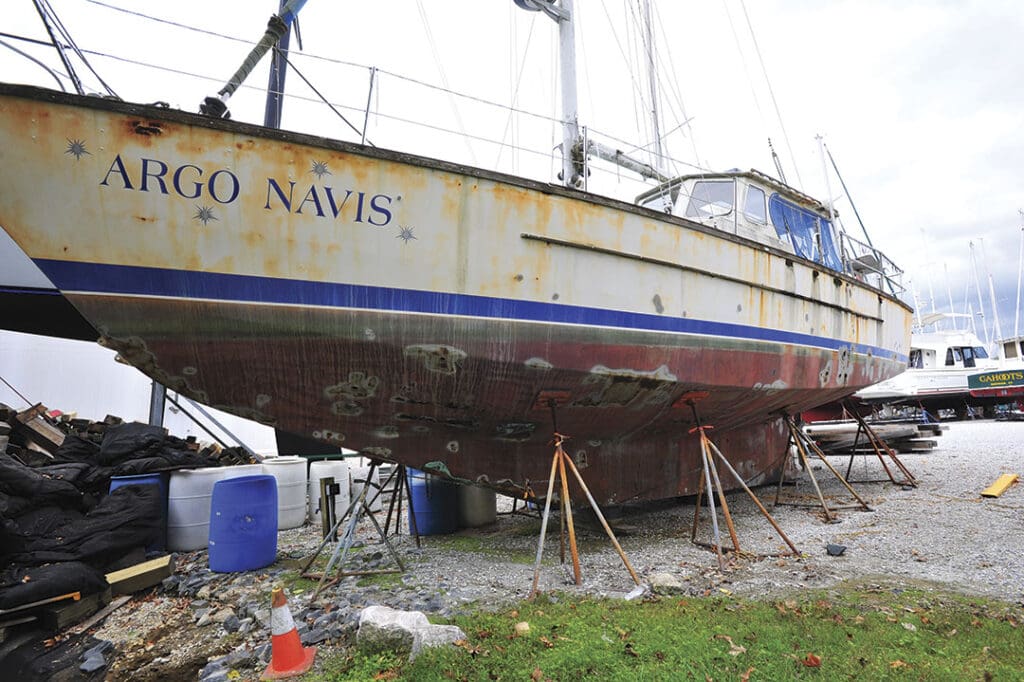
Rust is the enemy of every steel boat owner. Adding carbon to iron increases the metal’s strength but also ups its tendency to oxidize. As steel begins to corrode a powdery, rufous-colored scale quickly grows into flake-like layers of rust as the material’s strength and stiffness disappear. Steel ships are designed with a specific percentage of added plate thickness to account for corrosion over the vessel’s design lifespan (usually 20 years). Small craft designers can’t afford to add the weight of thicker plate and the design process seldom incorporates such corrosion compensation. Instead, contemporary coatings, meticulous preparation and application techniques will do a very good job of holding rust at bay.
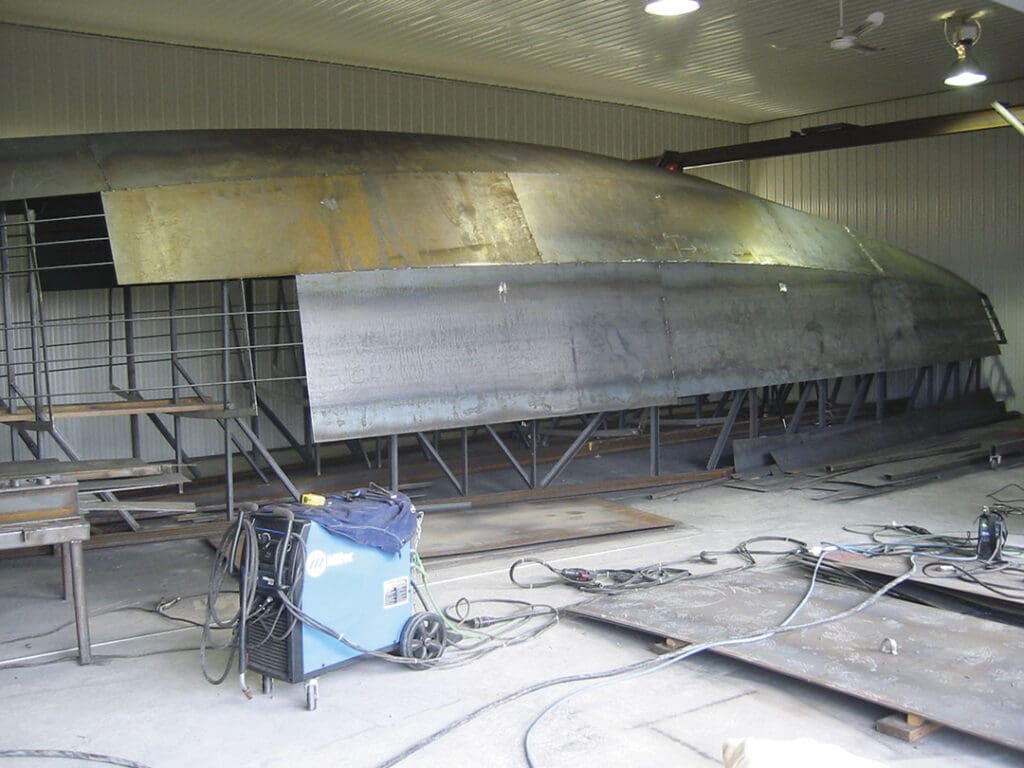
Streamlining steel boat construction defies the round bilge smooth curve status quo. And one of the biggest challenges involves generating hard chine aesthetic appeal and maintaining bilateral symmetry. In short, the challenge is bending flat plate into a functional hydrodynamic shape with enough aesthetic appeal to draw a sailor’s eye. In years gone by, master craftsmen struggled to twist and cajole steel plate over round bilge frames that incorporated compound curves galore. In many cases, several hundred pounds of epoxy filler had to be pasted to the hull, troweled out and sanded smooth with “long boards” to mimic the fairness of a timber or FRP hull. Today, single chine, multi chine and radius chine designs prevail. They are designed to minimize the slab-sided look and are much easier to build than a complete round bilge boat. The FRP production boat industry has helped by following automotive trends, and adding a chine to their racers and cruisers.
Fine tuning stability
The design challenge also includes how the significant weight of steel is handled. When it comes to vessels less than 50 feet, weight distribution becomes an even bigger issue. For example, to lessen weight above decks and still minimize deck flex, a designer must use thinner plate, 10- or even thinner 12-gauge steel. This requires shorter spans between transverse and longitudinal support or a switch to stiffer Corten steel. Some builders even switch to aluminum above the sheer, a weight saving alternative that ups costs and adds complexity.
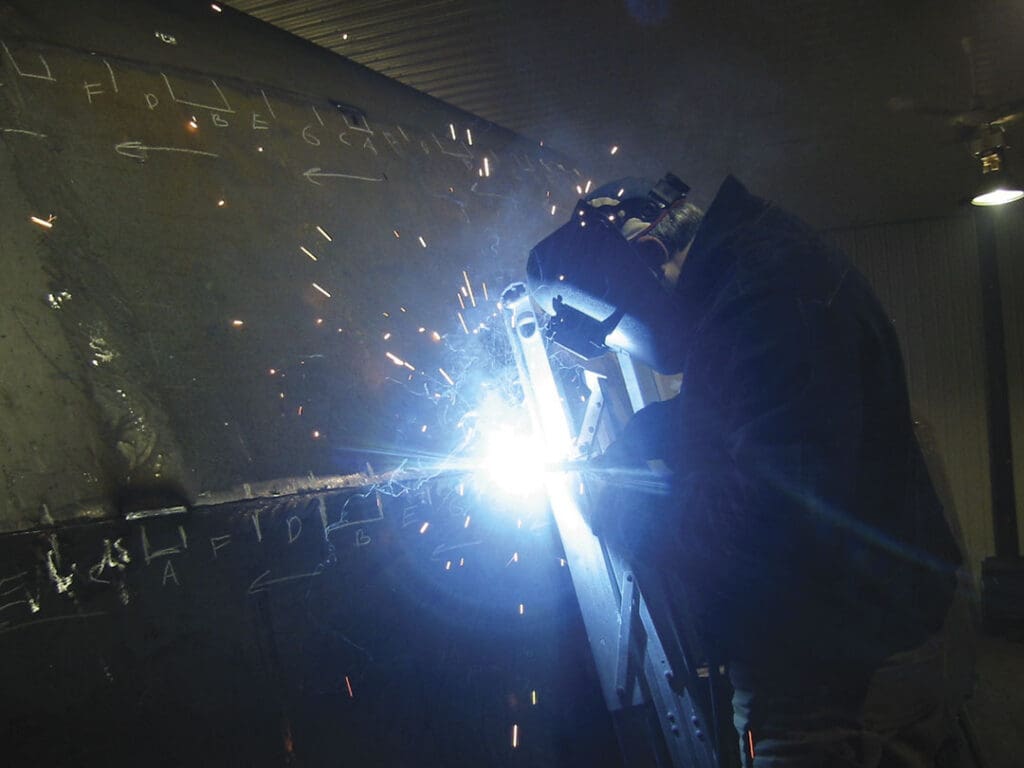
This metal transition requires the installation of an explosion welded bi-metallic strip that’s composed of aluminum bonded to steel. It allows a fabricator to conventionally weld one side of the junction strip to the hull’s sheer and then TIG or MIG weld an aluminum superstructure to the opposite side. Welding aluminum requires an inert gas to shield the arc, and the plate is harder to weld but easier to cut. The surface can be left uncoated, it will form a self-protecting, lightly oxidized layer that abates further oxidation. The steel hull, however, must be blasted, primed and painted inside and out. And as Michael Kasten professes, “clean and grit blast the surface, apply epoxy and avoid using sprayed-in foam insulation.”
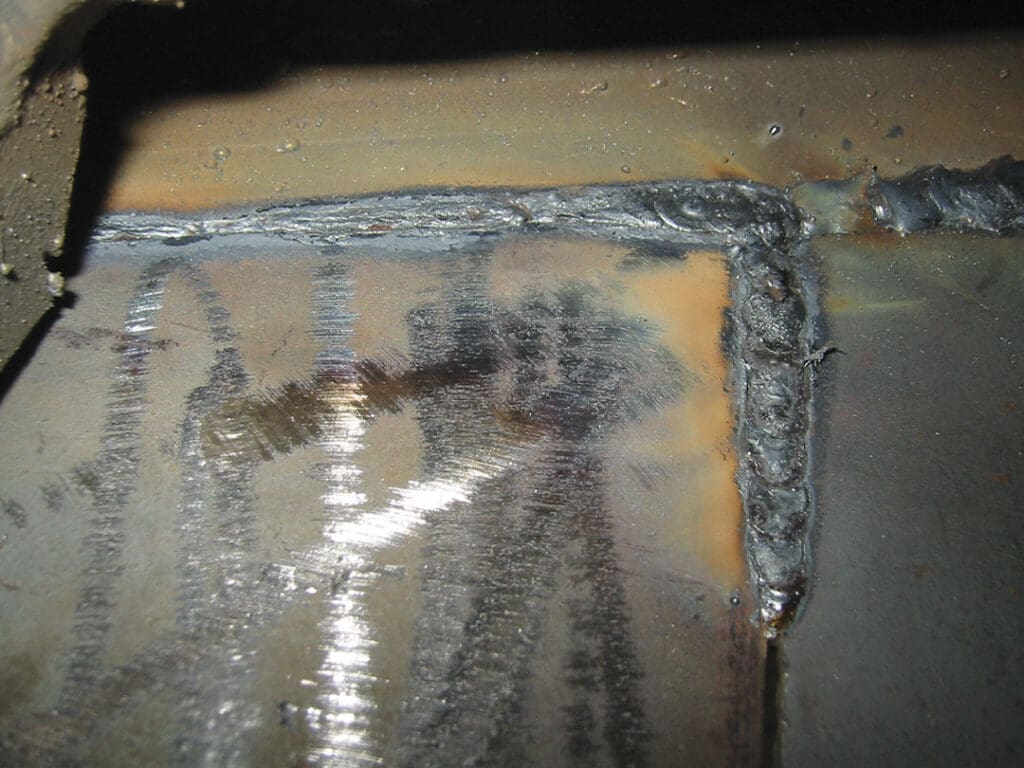
The all-steel alternative can also be designed as a seaworthy vessel if careful attention is paid to weight distribution and the height of the superstructure. Payload location can also be a vital consideration. During the design process, every effort should be made to place machinery and integral tankage as low in the bilge as possible. Chain, batteries, and heavier equipment should also reside in the dry spaces below the cabin sole. If a power cruiser is to be an offshore passage maker, these vertical center of gravity considerations rule out the double-decker riverboat look and it’s also wise to avoid perching a sizable runabout and lifting crane on the top deck, aft of a heavy flybridge. A fringe benefit found aboard lower air draft power cruisers is that it places cabin space closer to the waterline where there is less effect from pitch and roll and windage is lessened.
Sail and power
Over the last 40 years I’ve kept track of a small but hearty 45-foot tug/work boat built by Gladding-Hearn Shipbuilding in Somerset, Mass. Dragon belonged to a friend of mine and played a central role in his marine construction business. And whether he was pushing a small crane barge, towing a load of pilings up and down Long Island Sound or when the vessel was loaded up with a sunfish, whitehall rowboat and provisions for a summer family cruise to Block Island — Dragon fit the bill. For decades Captain Jim and now his oldest son Eric have followed a regular rust abatement routine. Their anti-corrosion strategy included regular inspections of hard-to-get-at confines and never painting over rust. The grinder and wire wheel effectively abraded small spots but grit blasting to “white-metal” status was used when appropriate. Their painting preference revolved around PPG Ameron products. High on their to-do list was changing zincs and meticulously servicing the trusty old Detroit 6-71 diesel.
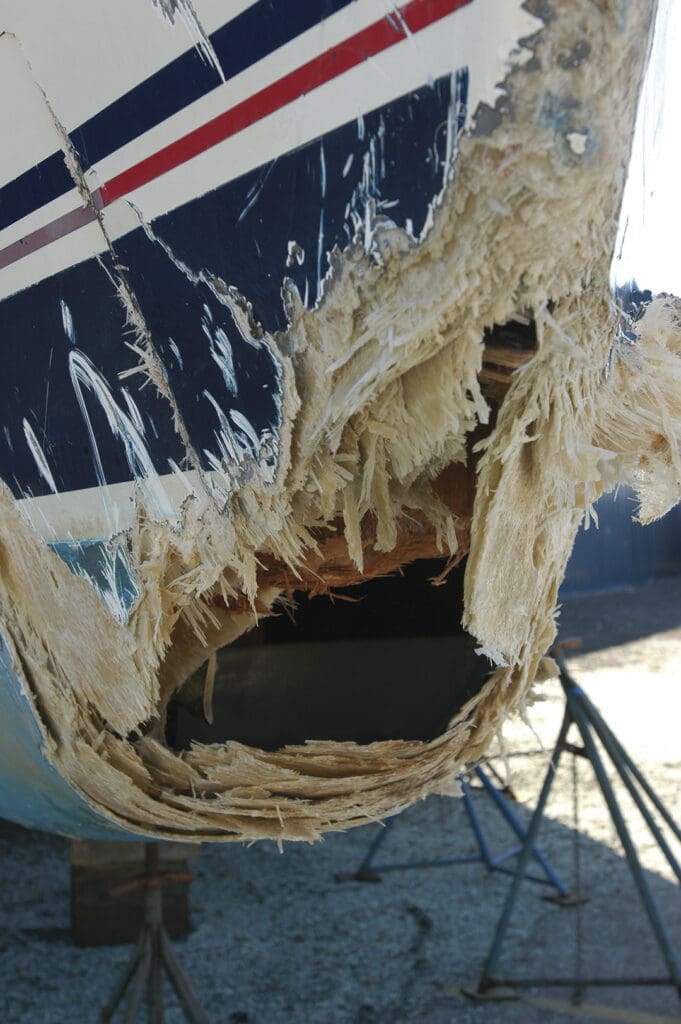
Steel sailboats and power cruisers still hold justified appeal, but it’s important to understand what ownership entails. This is especially true for those considering a DIY build of a steel cruising boat. A good starting point is a thorough review of both Bruce Roberts and Michael Kasten’s in-depth online commentary. There’s plenty of valid detail about building metal boats, both aluminum and steel. Those with experience in welding and metal fabrication have a very significant head start and finished hulls will reflect those who learn metal work during the project and those who start out with essential fabrication skills.
If you’re considering purchasing a steel cruising boat it’s essential to engage a skilled, metal boat-versed, marine surveyor. But before that develop a clear vision of what you are after. A handy way to compare vessels is through the use of parametric analysis. It’s basically, a straight forward spec comparison among two or more vessels and recognition of how the numbers relate to underway characteristics.
Two hulls compared
In this case I’ll compare my own well-seasoned 41-foot Ericson (18,000 pounds displacement (six-foot draft, 10’ 8” beam, 8,200 pound ballast, 750 square foot sail area) with a classic round bilge, steel 37-foot Zeeland Yawl, (18,000 pounds displacement 5’8” draft, 10’ beam, 5,700 pounds ballast, 550 square foot sail area). Though the two boats’ displacements are similar, the Zeeland Yawl’s working sail area is a lot less. This is likely due to a lower righting moment (ability to resist heeling). A further indicator of this diminished stability is the lower ballast/weight ratio, even though the displacement numbers are the same. The net result is a bit less ability to recover from a deep knockdown or capsize. The designer saw this and responded with a smaller sail area that induces less of a heeling moment.
In real world terms this means that the E-41 would be far more efficient sailing in light air as well as more likely to avoid a knockdown, even when both boats are deeply reefed. But when it comes to sailing higher latitudes with bergy bits floating by, or fetching up on an uncharted rocky shoal, the Zeeland Yawl’s Corten steel hull wins hands down.
The reason welded steel construction has dominated the maritime industry for decades yet made only a slight ripple in the realm of recreational small craft construction is multifaceted. In part it’s due to the production efficiency of molded FRP boat building, the ongoing concern over corrosion, plus the reality that most recreational craft aren’t put to the same rugged use as commercial vessels and work boats. However, for those who sail or power cruise well off the beaten path, steel hulls are still held in high regard and to rank number one when it comes to abrasion resistance and survivability in groundings, collisions, and other blunt force trauma. n
Ralph Naranjo is a circumnavigator and the author of The Art of Seamanship (International Marine/Ragged Mountain Press).

